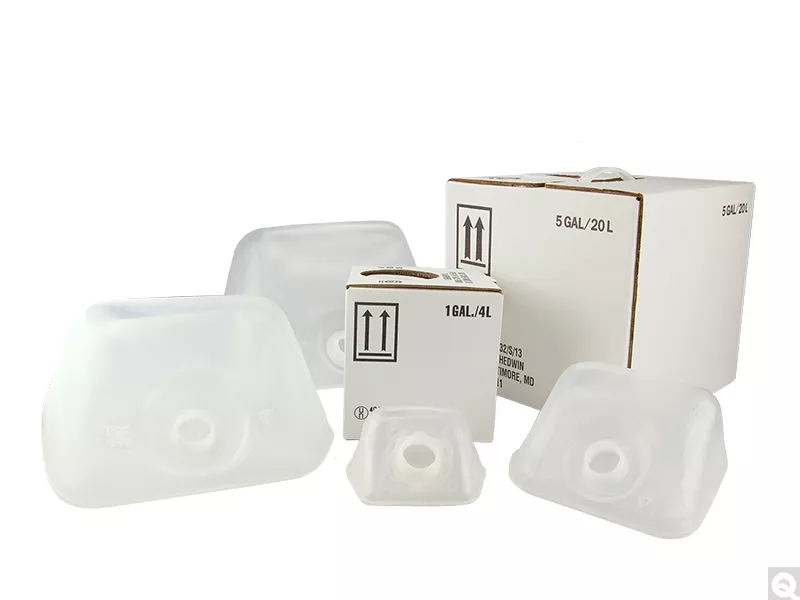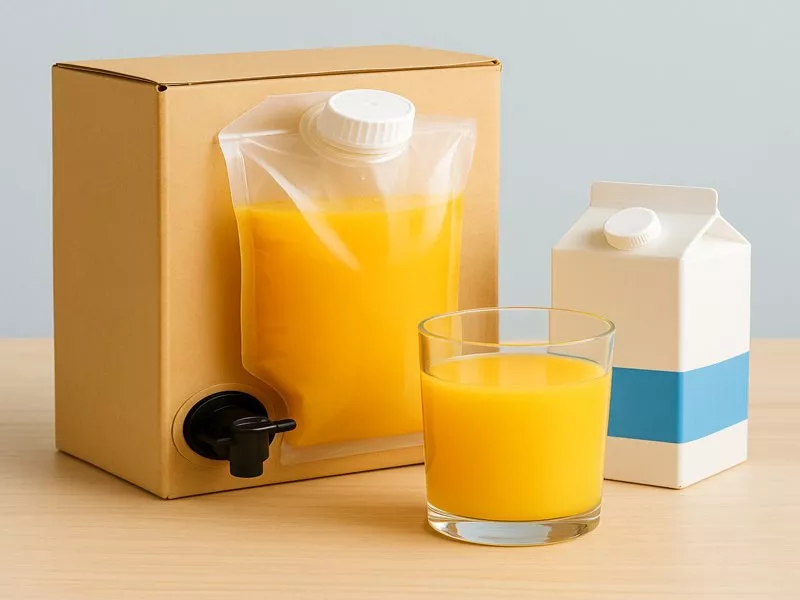For beverage makers and foodservice operators, two levers drive profitable growth: more days of saleable freshness and lower cost per liter delivered. Bag-in-Box (BiB)—a collapsible, oxygen-barrier bag with a hygienic tap housed in a protective carton—does both remarkably well for juices and dairy. Long a staple in post-mix soda and boxed wine, BiB is now mainstream for cafés, hotels, schools, institutional kitchens, and direct-to-consumer subscriptions where freshness, hygiene, and logistics matter.
This guide explains how BiB extends shelf life, where the real cost savings come from, the processing options (hot-fill, aseptic, ESL, HPP), and how to implement BiB without compromising flavor or food safety.
What Is Bag-in-Box and Why It Works
A typical BiB system has three parts:
- Inner bag – Multilayer, food-grade film (often PE with an EVOH oxygen-barrier layer). The bag collapses as product dispenses, so air does not glug back in.
- Fitment/tap – A push-button or quarter-turn spigot (e.g., Vitop-style) or a sanitary quick-connect used with dispensers. Designed to be leak-resistant and tamper-evident.
- Outer carton – Rigid, recyclable paperboard that shields the bag from light and impact, stacks efficiently, and doubles as the serving station.
The magic is the one-way flow: product exits, the bag shrinks, and oxygen exposure is minimized. Combined with a light-blocking carton, BiB slows both oxidation (key for juices and dairy fats) and light-induced off-flavors (notoriously in milk).

Shelf-Life: Why BiB Helps Juice and Dairy
Shelf life in juice and dairy is limited by microbial growth (managed by pasteurization/aseptic/HPP) and chemical degradation (oxidation, light). BiB improves the latter and supports the former.
1) Reduced Oxygen Pickup
- The inner bag’s oxygen transmission rate (OTR) is far lower than that of many commodity bottles.
- Because the bag collapses, no headspace refresh occurs with each pour—critical for vitamin-C-rich juices and cold-pressed blends.
2) Light Protection
The carton blocks UV and visible light, reducing color fade and “light-struck” flavors (riboflavin-catalyzed oxidation in milk). This is a common weakness of transparent bottles.
3) Hygienic Dispensing
Taps are engineered to prevent backflow and protect the product side from touch contamination—important in schools or self-serve breakfast bars.
4) Temperature Stability
Rectangular cartons pack densely, so the product chills evenly and stays cold longer in service, supporting ≤5 °C (≤41 °F)hold targets.
Reality check: Exact life depends on formulation, microbial load, fill technology, film spec, and temperature control. Always run validation studies for your product and market regulations.
Indicative Shelf-Life Ranges (Unopened / Opened, Chilled)
| Product & Process | Typical Retail Bottle/Jug | In Bag-in-Box (comparable process) |
| Pasteurized orange or apple juice | 7–14 days / 3–5 days after open | 21–30 days / 7–14 days after open |
| NFC cold-pressed juice (HPP) | 30–45 days / 5–7 days after open | 45–60+ days / 10–14 days after open |
| ESL microfiltered milk (chilled) | 14–21 days / 5–7 days after open | 21–30 days / 10–14 days after open |
| UHT dairy (ambient until opened) | 6–9 months / 5–7 days after open | 6–9 months / 10–14 days after open |

Cost Savings: Where BiB Cuts the Bill
BiB isn’t just a packaging swap; it rewires your unit economics.
1) Packaging Cost per Liter
A 10 L BiB typically uses far less material than 10 × 1 L bottles (no caps, labels, sleeves, or rigid walls), driving down cost per liter.
2) Freight and Storage
- Cube efficiency: Rectangular cartons fill pallets and trucks with a higher product-to-air ratio.
- Weight: Less packaging mass per liter reduces freight cost and handling strain.
- Cold storage density: More liters per shelf equals lower $ per pallet-day.
3) Labor & Service Speed
- One 10 L changeover equals ten 1 L swaps you no longer do.
- Self-serve taps reduce staff time at front-of-house beverage stations.
4) Waste Reduction
- BiB’s extended open life lowers spoilage.
- The collapsing bag yields near-total evacuation, cutting “unpourable” leftovers common in rigid bottles.
5) Equipment Synergy
With post-mix juice/dairy bases (concentrate + water at dispense), BiB produces massive logistics savings—shipping flavor, not water.
Example: Cost Snapshot (Illustrative)
| Cost Element (per 10 L served) | 10 × 1 L Bottles | 1 × 10 L BiB |
| Primary packaging | $4.50 | $2.20 |
| Secondary/tertiary | $0.90 | $0.40 |
| Inbound freight | $2.30 | $1.40 |
| Cold storage (pallet-day) | $0.80 | $0.50 |
| Disposal/handling | $0.60 | $0.25 |
| Total est. packaging+logistics | $9.10 | $4.75 |
Illustrative only; plug in your rates for precision. The pattern—fewer components, better cube, less waste—drives most savings
Which Process Fits: Hot-Fill, ESL, Aseptic, HPP
BiB is a platform that pairs with multiple processes:
Hot-Fill (Juice)
- Product enters BiB at ~85–92 °C, sterilizing contact surfaces.
- Suited to acid juices (pH ≤ 4.2).
- Choose heat-resistant films; manage cooling to avoid vacuum collapse beyond spec.
ESL (Extended Shelf Life Dairy)
- Microfiltration + high-temp short-time pasteurization, rapid chilling, ultra-clean filling.
- Requires sanitary fitments, strict hygiene, and cold chain discipline.
Aseptic Packaging (Juice & Dairy)
- Product and packaging are sterilized individually, then combined within a sterile environment.
- Enables ambient-temperature distribution until opening (UHT milk, shelf-stable juices).
- Needs validated sterile fitments and caps; often used with quick-connect dispensers.
HPP (Juice)
- Filled and sealed BiB passes through a high-pressure water chamber (~600 MPa).
- Extends the life of cold-pressed NFC juices with minimal heat impact.
- Ensure the bag, seals, and tap are HPP-compatible.
Tip: Align fitment geometry with your dispenser (gravity tap, countertop chiller, bag-squeezer, or post-mix system). For dairy, prefer enclosed sanitary connectors over open taps where possible.
Film & Fitment: What to Specify
- Barrier: EVOH layer thickness matched to expected life and distribution (higher barrier for vitamin-C juices; strong light block for milk).
- Seal strength: Drop and compression resistance for warehouse handling.
- Tap: Leak-proof, positive closure; for dairy, consider closed-coupled systems to avoid touch contamination.
- Carton: Wet-strength coatings for refrigerated condensation; printing for orientation and quick flavor ID.
- Sizes: 3 L/5 L for variety; 10 L/20 L for back-of-house economics.
Food Safety & Quality Management
- HACCP: Treat the fitment area as a critical control point; validate cleaning, fill temps, and closure integrity.
- CIP/SIP (for connected dispensers): Maintain routine cycles and document verification.
- Cold chain: Hold at ≤5 °C (≤41 °F) for pasteurized/ESL/HPP; ambient allowed for UHT until opening.
- Rotation: Use FIFO; date-code outer cartons.
- Tap hygiene: Assign drip trays, wipe taps daily (alcohol wipes), and replace bags at the first sign of damage.
Implementation Playbook (Pilot → Scale)
Define the objective
- Shelf-life extension target (e.g., +10 days)
- Cost KPI (¢/L savings) and waste KPI (% spoilage)
Select format & process
10 L hot-fill juice? 5 L HPP cold-pressed? 20 L of aseptic milk for cafeterias?
Lab & line trials
- Verify barrier spec, seal integrity, drop/pressure tests, and tap torque/flow.
- Conduct abuse testing (temperature excursions, rough handling).
Shelf-life study
- Micro, chemical (ascorbic acid retention, peroxide value), sensory over time at target temps.
- Compare against 1 L retail packaging to quantify gains.
Dispense integration
- Match fitment to gravity trolleys or refrigerated countertop dispensers; train staff.
- For dairy, prefer closed tubing to limit exposure.
SOP & training
- Receiving, storage, opening, tap sanitation, changeovers, and end-of-life recycling.
- Visual work instructions at the station (icons for fast adoption).
Scale & audit
- Lock specifications, audit fills, and incoming QC.
- Track KPIs: freshness complaints down, waste down, labor minutes per liter down.
Sustainability Considerations
- Lower packaging mass per liter vs bottles/jugs; fewer truckloads for the same volume.
- Cartons are widely recyclable; inner bags/taps may require store drop-off or specialty programs.
- Extended freshness means less product waste, which is a major sustainability win.
- In post-mix systems, concentrates in BiB slash transport emissions further.
Final Take
For juice and dairy, Bag-in-Box aligns technical performance with business reality:
- Longer freshness after opening through oxygen control and light blocking.
- Lower total delivered cost via cube efficiency, reduced packaging, quicker service, and less waste.
- Flexible processing—hot-fill, ESL, aseptic, HPP—without changing the consumer experience at the glass.
- Scalable operations with fewer changeovers and simpler inventory.
If you’re ready to trial BiB, start with a 10 L format in your highest-velocity SKU, pair it with an appropriate tap or closed connector, and run a side-by-side shelf-life and cost study for four weeks. In most cases, the data speaks for itself: more days of great-tasting product, fewer dollars tied up in packaging and waste.
